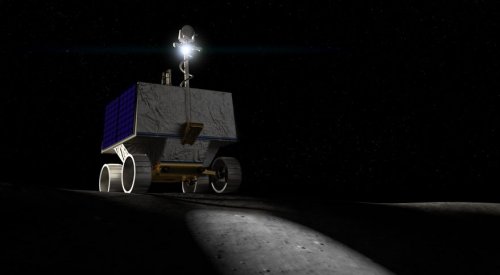WASHINGTON — NASA Administrator Jim Bridenstine announced Oct. 25 that the agency would send a robotic rover to the moon in 2022 to look for water ice, confirming plans that had been taking shape for months.
In a speech at the 70th International Astronautical Congress, Bridenstine said the Volatiles Investigating Polar Exploration Rover (VIPER) mission would look for ice on or below the surface of the moon at its south pole, a key resource for future human missions.
“We actually have a mission right now that I’m very pleased to announce, it’s called VIPER,” he said. VIPER would fly to a moon on a commercial lander through the agency’s Commercial Lunar Payload Services (CLPS) program.
“VIPER is going to rover on the south pole of the moon and VIPER is going to assess where the water ice is,” he continued. “We’re going to characterize the water ice, and ultimately drill and find out just how the water ice is embedded in the regolith on the moon.”
Bridenstine and others have long trumpeted the presence of potentially hundreds of millions of tons water ice on the moon as a key reason human missions should go to the lunar poles. However, there’s little “ground truth” about that water ice, including exactly where it is located and in what concentrations, as well as how difficult it would be to extract that water ice.
The $250 million VIPER mission would launch in late 2022 and operate at the south pole of the moon for 100 days. The rover will use a neutron spectrometer to detect potential ice deposits below the surface, then access them with a drill than can go as deep as one meter into the surface. Subsurface samples retrieved by the drill would then be examined by a mass spectrometer and near-infrared spectrometer.
“It’s incredibly exciting to have a rover going to the new and unique environment of the south pole to discover where exactly we can harvest that water,” said Anthony Colaprete, VIPER project scientist, in a NASA statement. “VIPER will tell us which locations have the highest concentrations and how deep below the surface to go to get access to water.”
While Bridenstine announced the mission in that speech, agency officials have been discussing plans for VIPER in industry forums for several months. The rover is intended to be part of a “mobility strategy” for lunar exploration, Steve Clarke, deputy associate administrator for exploration in NASA’s Science Mission Directorate (SMD), said at the NASA Exploration Science Forum in July.
NASA had been studying another rover mission for several years, called Resource Prospector. However, the agency cancelled the mission in 2018, arguing that the agency could instead fly instruments from the rover on CLPS landers.
VIPER “heavily leverages the Resource Prospector engineering that we’re in the process of archiving now,” said Jay Jenkins, program executive in SMD’s Office of Exploration, during a panel at the Wernher von Braun Memorial Symposium in September. “But unlike Resource Prospector, we’re going to be delivering that on a CLPS lander.”
Another key difference is mission duration. Resource Prospector was intended to last just 14 days, while VIPER’s mission is currently slated for 100 days. VIPER will take advantage of locations near the south pole that are in sunlight for most of a lunar day to enable that extended mission.
Jenkins acknowledged last month that the agency had a “very aggressive schedule” to get the mission launched by the end of 2022. “In order to do that, we are employing efficient processes,” he said, such as those for the Lunar Crater Observation and Sensing Satellite (LCROSS) mission that impacted the moon in 2009 as part to search for water and other volatiles, a mission that went from “cradle to grave within two years.” Like Resource Prospector and LCROSS, VIPER will be managed by NASA’s Ames Research Center.
VIPER, described as the size of as golf cart, is too large to be carried to the moon on most CLPS landers currently under contract with NASA. The agency recently held an “on ramp” to the program, seeking proposals for landers with enhanced landing capability capable of placing several hundred kilograms of payloads on the surface. Proposals for that CLPS on ramp were due to NASA in September, and the agency expects to select one or more companies by the end of the year.
- Mixed reactions to accelerated moon plan
- NASA opens the floodgates for firms with planetary ambitions
- Is the Gateway the right way to the moon?
- NASA argues Resource Prospector no longer fit into agency’s lunar exploration plans
- NASA emphasizes commercial lunar lander plans with Resource Prospector cancellation
Share with your friends

(0) Comments
This article comments are currently no :(